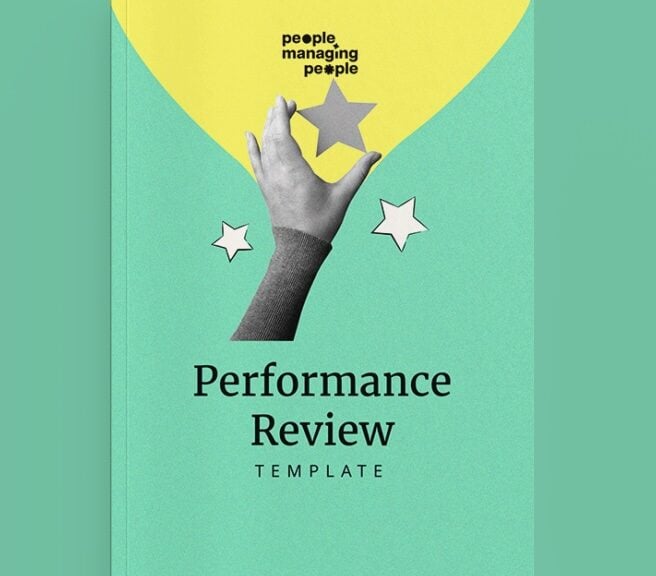While performance reviews might not be everyone’s favorite process, we cannot ignore their value as an opportunity for managers and direct reports to have a purposeful and focused conversation about an employee’s performance, contributions to the organization, and opportunities to improve.
A properly conducted performance review can increase employee engagement and lead to an uptick in an employee's performance. But be aware the opposite impact can occur too!
Drawing from my experience conducting countless performance reviews and helping organizations optimize theirs, I’ll share how to prepare for and conduct an effective performance review.
How to prepare for a performance review
Preparing to facilitate a performance review is not a task to take lightly, and it's certainly not something to do the night before the performance review is to be given!
Performance reviews take time to craft. If you rush it, your people will know.
Step 1: Reflect on your team and employee’s performance
The first step in preparing for a performance review is to reflect on the individual’s performance and also assess the performance of teams.
Consider what has happened that has been positive, neutral, or negative. What happened that was outside of the control of the team or individual? How does the individual contribute to the team? A reflection on these points is a great way to start.
Another thing to consider is your own perception. If you don’t work with the individual in their day-to-day, who does and who could give you information about how the team member has been performing recently?
Especially in cases where I manage highly independent employees, collecting feedback from peers can be exceptionally helpful in conducting fair, accurate, and valuable performance reviews.
Oftentimes, a 360-degree feedback process is used (especially for manager performance reviews) but this can be time-consuming. You can quickly collect feedback from colleagues about your team member’s performance using Google or Microsoft Forms.
As you reflect on the strengths and areas for improvement, getting ideas from examples of performance review phrases can provide clear, actionable feedback to your employees. I then use bullet points to identify a few things for each employee under the prompt.
In essence, I’m doing a shorthand version of the performance review which I will then expand in my narrative to include examples and recommendations for the future.
Step 2: Draft your feedback and link it to the expectations of the role
Once you’ve gathered your thoughts, any necessary peer feedback, and made your outline of the review, you’re then ready to write the performance review.
Writing the narrative is one of the most important parts of the review.
Arguably, this stage might be more important than the live conversation itself, especially in cases when you’re giving developmental feedback and you’re expecting an individual to change their behavior as an outcome of the meeting.
The narrative, in written form, is a document that people will go back to review their feedback, and it’s also an official document outlining performance and performance feedback for an individual employee. It's an important of the performance appraisal and overall performance management process.
Narratives of performance reviews (the written part) should always include performance statements, comparisons to the expectation or expected behaviors (performance gaps), detailed examples of good or poor performance, and how their performance impacts others.
KPIs and metrics are great measurement tools to be used in evaluating performance, identifying opportunities, and setting future goals for performance.
For example, if someone is in sales, you can outline their quality of work and accountability by noting how much they were able to meet the set goals and metrics. Just as goals should be measurable, so should performance.
Narrative example
“Brent continues to struggle with detail orientation, especially when configuring our learning management system. The impact of Brent missing details, such as course enrollment, is that employees are not assigned to the courses they are required to complete. When people are not assigned to the right courses, such as compliance training, this means we as a company are out of compliance because we have not effectively facilitated the required compliance training.”
In addition to the narrative with concrete and measurable examples, you as the reviewer and leader should also be ready to describe how you’ll help the individual improve their skills or adopt the desired behavior.
Yes, performance review narratives can be long, but, in my experience, a longer, more thorough narrative is most helpful when working to help employees understand their performance and to document performance for the longer term.
Step 3: Prepare to deliver the performance review
Once you’ve collected your thoughts and any additional feedback, reflected on an individual’s performance, and written the narrative, you’re now ready to prepare to deliver the performance review.
If you’re preparing to have a hard conversation, game-plan how you'll kick off the discussion and consider a few questions you think the team member will have at the outset. Be prepared to speak to each point with concrete examples.
Personally, I like to start on a positive note and highlight the good contributions the individual has made to the team in the review period. Then I dive into the constructive criticism and opportunities for growth along with what I plan to do to support the employee along their journey.
Conducting A Performance Review
You’ve completed the reflection and narrative creation and are prepared for the conversation.
However, be aware that you don't need to stick to the script and plod through your performance review questions if something interesting arises during the review itself.
The team member you’re conducting the review with will likely bring up something interesting that will lead you off-script. These kinds of performance review comments are worth their weight in gold and you’ll want to explore them further when they come up.
Delivering performance feedback is a bit of an art and requires emotional intelligence, empathy, and active listening to get it right. Here are a few top tips for facilitating an effective performance review conversation.
Avoid one-sided conversations
When it comes to actually performing a performance review, it's easy to think that it's going to be a one-sided conversation with you as the manager telling your team member how they’re doing.
This is the exact behavior you need to avoid by training managers ahead of performance appraisals! A performance review conversation should be a two-way conversation.
When an employee talks about their performance, they learn and understand the reflective feedback much more than if you simply tell (or read) it to them.
Effective performance management can only be achieved if you facilitate a conversation to both share your reflective insights and obtain feedback from the employee or reviewee.
By giving constructive feedback, and having an open conversation, the review process will glean deeper insights on both sides, which will lead to greater performance over time.
Honesty is the best policy
One of the worst things that you can do in an employee performance review meeting is tip-toe around issues. This is true not just on performance review day but every day as performance management happens in real time, and is specific and actionable.
It's easy for barriers to exist between managers and an employee regarding communication and transparency. It's human nature and frequently requires a conscious effort to address.
One of the best ways to express your honesty during a performance evaluation is to think about what you know about the employee and how you think they’d like to receive feedback. It's a twist of the golden rule: treat others how they would like to be treated.
Some people may prefer you to be blunter, while others will need some easing in. We're all different when it comes to that.
If you're still struggling with honesty, one tip is to step back and look at your communication and other soft skills.
Regardless of what you do, always ensure that you end things on a positive, opportunity-focused note. You want them to leave the conversation feeling inspired and appreciated and with a clear roadmap of where they can improve.
Provide detailed feedback
When you're giving feedback, you don't want to be vague. You don't want to be sweeping broad strokes and just talking in analogies. You need concrete details and examples, especially when highlighting opportunities for improvement.
Perhaps there was something they did on a project last month that you want to bring up; maybe they got a project back on schedule or had a hand in things falling behind.
Be specific when explaining an example of performance, and be sure to highlight the impact of the good or not-so-good performance. Look at how their performance aligns with values and company goals and provide structured guidance on what worked and what didn't.
By being specific and highlighting the impacts of behaviors, you help the person receiving the information understand how what they did impacts other people.
The more concrete examples you can give to back up your feedback, the better. I know examples can be hard to come up with if reviews aren’t so frequent.
This is why it's better to conduct performance reviews more frequently, such as monthly or quarterly reviews, with a review period near the time the review is delivered. That way you can use examples whilst they’re fresh and the details are still clear.
Take your time and listen actively
When conducting the review, present your feedback and check for reactions: body language, tone of voice, and words.
When you give feedback, especially negative feedback, you might notice them go into flight mode and they’ll stop listening!
You also need to be empathetic to their viewpoint and on the lookout for interesting points they might raise during the review.
Don’t gloss over the opportunities to improve; take time to go over all of the feedback and discuss ways to address the feedback, including what you can do as a manager to contribute to an their growth.
Lead with empathy
Consider the environment and world of the individual you’re giving the feedback to. You never know what’s going on in someone’s life and, often, people don’t tell us about the most impactful, important things that are going on.
Practice empathy, don’t assume you know everything is going on, and give your people grace.
Make use of available tools
There are plenty of employee evaluation tools available to help while conducting performance reviews. Why not make use of them? They help make everyone's lives easier.
What tool you choose will depend on your organization, your working style, and how you go about conducting performance reviews.
One of my favorite features of performance management software is the opportunity to document follow-up along with the review itself so that you or a future manager can look back on the feedback and any notes of the conversation and the committed follow-up.
As a manager of people over a longer horizon, these are also great reflective tools to see how far your employees have come in their development. If you don't use them yet, PMP's reviews of the best performance management software is a useful resource to start looking.
Finally, you'll also have to consider how AI can impact performance reviews. Whether that's you using an AI driven tool, or incorporating gen AI into your own workflows, there's no shortage of ways AI is influencing performance management.
Get used to giving feedback continuously, both good and bad
If you manage people, one of your primary duties is giving relevant, detailed feedback continuously—both good and bad. Giving regular feedback is an essential skill of management.
Focus the feedback on the behaviors, impacts, and outcomes of employees and consider your role and responsibility in developing your people.
Do not hold on to negative feedback over time, and do not wait for the next performance cycle to give feedback, especially negative feedback. Feedback, criticism, or developmental notes should never be a surprise in a performance review.
Brush up on giving effective feedback that is timely, specific, and outcome-focused.
Align your feedback with the expectations of the role
All roles and performance measurements require clear expectations to be effective.
Remember, a performance evaluation is intended to compare the individual’s performance in the role against the requirements of the role, not against their past performance or the performance of other teammates.
This is often confused and disaster occurs when performance is compared to anything that is not the clear expectations of the role.
If the role you’re evaluating does not have a job description with clear responsibilities, goals and KPIa, it’s time to get to work writing one so that future performance reviews can be based on an evaluation against clear, written expectations of the job.
Consider the context and structure of the performance review
If using scales or ratings, ensure alignment with the organizational expectations and norms.
Avoid being the manager who “never gives fives” in an organization where a top rating is given by other managers.
Often your HR team will have statistics on the portion of employees that typically receive each rating, use this information to your advantage in understanding how good performance is evaluated at your organization.
Often, the people performing at the highest levels are very aware of performance ratings and may be discouraged if their current performance rating is less than their previous rating, especially if they feel they have been working harder than normal in recent times.
Consider the impact of performance evaluations for high-performing individuals and how these people are motivated. Don’t let your cursory review of a strong employee’s performance cause a retention issue (yes, this is a very common problem).
Check your bias
Consider gathering feedback from multiple sources to mitigate bias in your reviews, especially if you don’t work super closely with your individual employees in your day-to-day.
For example, when I evaluate project managers, I know that my opinion of them as their manager is not actually what matters; instead, what matters are the opinions of those that the project managers serve.
To get this information, I send feedback requests to the key stakeholders of each project manager and gather feedback both about the performance of the individual project manager and the perception of the project management team.
Give people the opportunity to reflect on your feedback
Get further clarity and ask questions. Often people need time to process information, and they may benefit from time to read your review, think about it, and then come to you with questions.
When conducting a performance review, leave the conversation somewhat open to invite further discussion and inquiry and to signal to your team member that you are there for them and committed to helping them grow personally and professionally.
Common Performance Review Examples
Let's now get into some review phrases you can make use of.
To begin with, you want to start with categories and prompts to cover during the performance review.
This is by no means a definitive list. Feel free to pick and choose and add in what you want, but, to get started, consider the following elements that can apply to almost every role in an organization:
- Strengths
- Opportunities for improvement
- Problem-solving
- Communication
- Teamwork
- Accountability
- Quality of work
With each of these, you can then create specific performance notes highlighting positive or less-than-desirable examples of behavior exhibited during the review period.
Positive performance review regarding communication:
“Moriah’s communications are crisp, timely, and comprehensive. She excels at making sure the people that need to know do know. For example, when Moriah led the launch of our new product update, all stakeholders were informed and even had an opportunity to ask questions before the launch. Moriah navigates our fast-paced environment, balancing business outcomes while ensuring we are doing the right thing for our employees.”
Less positive review about communication:
“Sandra is a strong communicator but does not communicate key details of projects with stakeholders consistently, meaning some people are left in the dark on key matters. For example, in the website redesign project, Sandra and the team decided on when the new pages would launch, but Sandra did not lead the team in informing the leaders and the rest of the staff about the upcoming website change. When released, it caught many people, including our CEO and key sales leaders, by surprise.”
Positive review regarding quality of work
“Moriah’s quality of work is exceptional. She sets the gold standard for planning, productivity, and organization to the point that others across the organization specifically request to work with her because they trust the quality of her work and consistency in her delivery. She is also contributing to developing others by training them on her practices and producing templates to help others learn similar quality skills.”
Less positive review regarding quality of work
“Sandra is capable of producing quality work, but only produces her best work when partnered directly with me, checking each incremental step along the way and making sure that Sandra is actively pursuing completion of the task. For example, Sandra committed to delivering a recommendation for changes to our learning system this quarter. When I approached Sandra to ask about the progress of this goal, she informed me that she had not yet started work on the task that was coming due in just a few weeks. Sandra got started but needed a significant amount of direct interaction with me to make it through the task, including a few course corrections such as compliance requirements and reporting. Further emphasis and skill in time management, understanding the requirements of the task, and keeping stakeholders informed along the way will help to improve the quality of Sandra’s work.”
Remember, be specific. Using concrete examples to help justify your comments in each area will generate much better feedback rather than vague phrases like "they are a team player". The more you can justify it with prior examples, KPIs, and metrics, the better.
Here’s a useful template to help you:
Performance Review Template

Get our Performance Review template!
Performance Reviews Are A Crucial Aspect Of Performance Management
As a manager, performance reviews are one of the most impactful activities you execute in your role.
If you’re a human resources leader, one of the core elements of your role is to help managers learn how to give effective performance feedback and facilitate performance reviews that motivate employees to perform their best.
But we can go further than reviews. Most successful companies, like Google's performance review process for example, use a system of continuous performance management that focuses on ongoing communication and feedback between managers and employees.
Another pro tip is to engage in performance calibration from time to time to ensure managers are assessing objectively using the same measures across the org.
Key takeaways
- As a manager, you should give both positive and negative feedback constantly, and all feedback should include specific examples and the impact of the behavior
- Formal performance evaluations should occur frequently, either quarterly or semi-annually if possible.
- Each role should have clear expectations for performance. Performance evaluations are to be done against the expectations of the role, not of an individual’s past performance or the performance of other team members.
- Ensure every employee has an opportunity to reflect on their performance as well.
- To prepare for the performance review conversation, document the highlights and opportunities of the individual’s performance in a narrative.
- Have a one-on-one conversation with the individual to go over both their assessment and your feedback on their performance. Throughout the conversation, share specific examples and concrete details of both positive and negative behaviors and their impact on the organization.
- After the performance review conversation, commit to any next steps and follow up via email or in your organization’s performance management tool.
- Remember, as a manager or evaluator of performance, you’re a key component of an individual employee’s growth and development. Be a partner, be honest, and be prepared to watch your employees soar to new heights!



